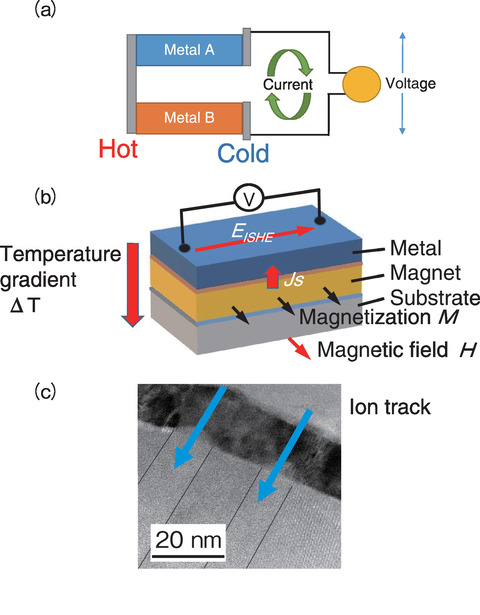
Fig.3-7 Conceptualization of (a) thermoelectricity and (b) a device based on the spin Seebeck effect (SSE), (c) photo of the proposed device irradiated with 320 MeV of Au ions

Fig.3-8 Performance of the proposed devices under ion irradiation
Thermoelectric (TE) devices convert heat to electricity and are important for recycling and reusing waste heat in cars or factories. Nuclear batteries, which combine a TE device and a radioisotope, can be used as an electric sources for spacecraft in deep space. A TE device is similar to a thermocouple, which comprises a junction between two dissimilar metals or semiconductors. Applying a thermal gradient across this junction generates an electric voltage, causing a current to flow through the circuit, as shown in Fig.3-7(a). However, such junctions in classical TE devices are sensitive to radiation and must be shielded from the radioisotopes of the nuclear battery.
Spintronics refers to a developing subset of microfabrication techniques at the atomic level that considers the spin of electrons, one of the inherent magnetic properties of electrons. Recently, TE devices based on spintronics (i.e., spin TE devices) have been developed and demonstrated to provide excellent results. Furthermore, spin TE devices are expected to tolerate radiation well, although this has yet to be demonstrated experimentally. Embedding spin TE devices in nuclear batteries may lead to the development of a TE system resistant to radiation; however it is unclear how long the spin TE devices can work with radioisotopes. Therefore, we developed a spin TE device based on the spin Seebeck effect (SSE) and aimed to confirm its resistance to radioisotode. The proposed device has a metal/magnet bilayer structure deposited on a substrate. The interface between the layers is important to the ability of the TE to generate electricity (Fig.3-7(b)).
The fabricated sample devices were irradiated with swift heavy ions (320 MeV of Au ions) to ensure the existence of severe boundary conditions and simulate near spent nuclear fuel. The resulting ion tracks are shown by the blue arrows in Fig.3-7(c). Here, the zone within the black lines is a nano-scale amorphous defect caused by an ion. This region is no longer magnetized and thus cannot contribute to the electricity generation by the device. The measured magnet strength and electricity generated under varying irradiation doses are summarized in Fig.3-8. The measured device voltage (•) decreased as the irradiation dose increased, and diminished to zero after a dosage threshold. These results demonstrate clear usage limits of the proposed device under heavy ion irradiation and could be used to determine a cumulative upper limit of irradiation by fission fragments near spent fuel. In general, a dose rate of approximately 100 MeV of fragments emitted from the fuel surface can be estimated from the actual neutron dose on the fuel cask surface. Converting the experimental usage limit to the actual TE device running time using this fragment rate, we estimate that the proposed TE device based on the SSE can maintain its performance for a few hundred years.
This study was partially supported by the Japan Society for the Promotion of Science (JSPS) KAKENHI Grant-in-Aid for Scientific Research (C) (No.JP17K05126).
(Satoru Okayasu)